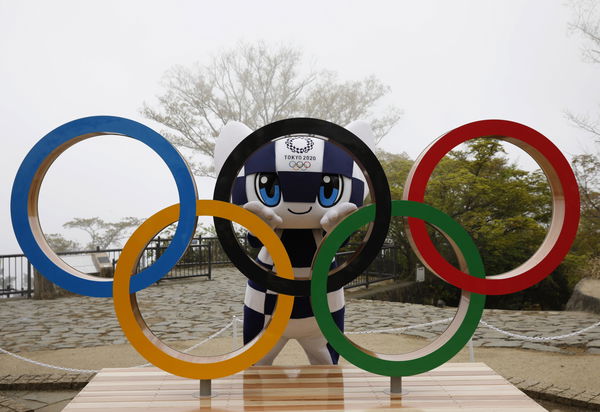

Equestrian in the Tokyo Olympics 2021 features three unique sports. From dressage to eventing to show jumping, every sport has its fanbase and talented athletes. The most recognisable but not so popular sport in equestrian is show jumping. Let’s look at the rules and structure of this historical sport.
Watch What’s Trending Now!
Show jumping at the Tokyo Olympics 2021

Getty
HACHIOJI, JAPAN – APRIL 14: Tokyo 2020 Olympic Games mascot Miraitowa poses with the Olympic Symbol after unveiling ceremony on Mt. Takao to mark 100 days before the start of the 2020 Tokyo Olympic Games on April 14, 2021 in Hachioji, Tokyo, Japan. (Photo by Kim Kyung-Hoon – Pool/Getty Images)
The sport show jumping is exactly what it’s called, a horse-rider combination leaping over a set of obstacles. Introduced to the Olympics in 1900, this sport has grown into an enjoyable experience for both athlete and viewer. No particular horse breed is better in show jumping than others, making it a level playing field.
ADVERTISEMENT
However, few teams and legends have dominated this sport.Germany’s Hans G?nter Winkler and Italy’s Raimondo and Piero D’Inzeo are three of the most successful athletes in show jumping. Currently, Germany’s Daniel Deusser leads the jumping world rankings, but only has one Olympic bronze to his name. He will gun for gold to maintain his position as the world #1.

Getty
CANNES, FRANCE – JUNE 09: Jessica Springsteen competes at International Longines Global Champion Tour – Day 1 on June 9, 2016 in Cannes, France. (Photo by Jacopo Raule/Getty Images)
The star-studded US show jumping team features not just three former medalists but a young world champion with a huge mainstream following. Jessica Springsteen, McLain Ward, Laura Kraut and Kent Farrington will look to continue the US dominance in show jumping.
ADVERTISEMENT
Attire for show jumpers is very similar to dressage riders. An ASTM/SEI helmet with a harness is a compulsory item, along with a choker/stock tie, tall boots (spurs are optional), red/black jackets and light-colored breeches.
ADVERTISEMENT
Structure of show jumping at the Tokyo Olympics 2021
ADVERTISEMENT
For the show jumping competition at the Tokyo Olympics 2021, team and individual competitions run separately. The individual competition begins first and goes on for two days. The first day serves as a qualifier with 75 rider-horse combinations tackling a course with twelve to fourteen obstacles. All combinations go through the same course, after which the top 30 advance to the individual final.
Top Stories
New Charter Deal Triggers ‘Financial Frenzy’ as NASCAR Teams Set for Massive Payday

NFL Files Motion to Dismiss Former Texans Board Member Cary McNair’s “Legally Baseless” Lawsuit

T.J. Watt’s Wife Shares Emotional Update on Steelers LB Following Worrying Health Scare

Athing Mu-Nikolayev Leaves Coach Bobby Kersee After 3 Years, Raising Big Questions About Future

NASCAR Broadcasters Asked to Issue an Apology to Michael Jordan & Co. After Lawsuit Settlement

Forced to Leave FOX, Cowboys Legend Troy Aikman Says ESPN Is Like ‘U.S. Government’ & Clearly Distinguishes the Two Networks

At the individual final, the combinations tackle a different course with more obstacles. The winner is the athlete who racked up the least penalty points. In case of a tie, the athletes will compete in a jump off, where both athletes go through the course again with the fastest timing winning.
ADVERTISEMENT
The team competition also begins with a qualifier where 20 teams begin. The top ten teams move on to the finals, where the winner is based on the accumulated number of penalty points.
Rules and scoring for show jumping
ADVERTISEMENT
The rules for show jumping are straightforward, unlike eventing and dressage. The athlete-horse combination with the least penalty points racked up qualifies for the finals, and the same method determines the winner. But what are penalty points in the first place?
ADVERTISEMENT
Penalty points apply when a combination breaks a rule and include various types. Jumping penalties apply when a horse refuses to jump over and obstacle or knocks it down. Time penalties apply when a combination does not finish the course within the given time frame. A combination penalty applies when a horse refuses a series of obstacles, requiring the rider to begin from the start.
Four faults or penalty points apply for jumping penalties while timing penalties lead to one penalty point applied for every late second. For example, if a combination completes a set in 62 seconds, two seconds over the given 60 second limit, two penalty points will apply. If they complete it in 62.3, three penalty points will apply as time penalties apply to even a fraction of a second.
Although the rules seem stringent, the FEI has done a magnificent job in stratifying show jumping.
ADVERTISEMENT
Read more: Tokyo Olympics 2021: Three Debutantes Who Could Steal the Show in Equestrian
ADVERTISEMENT
ADVERTISEMENT
ADVERTISEMENT

